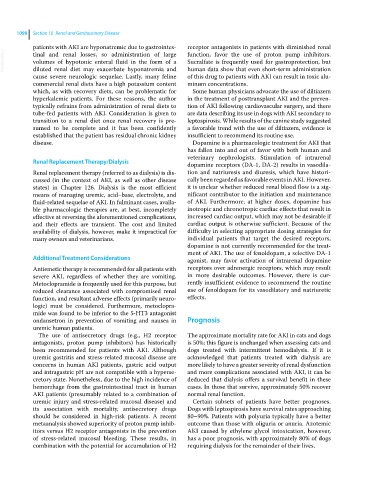Page 1160 - Clinical Small Animal Internal Medicine
P. 1160
1098 Section 10 Renal and Genitourinary Disease
patients with AKI are hyponatremic due to gastrointes- receptor antagonists in patients with diminished renal
VetBooks.ir tinal and renal losses, so administration of large function, favor the use of proton pump inhibitors.
Sucralfate is frequently used for gastroprotection, but
volumes of hypotonic enteral fluid in the form of a
diluted renal diet may exacerbate hyponatremia and
of this drug to patients with AKI can result in toxic alu-
cause severe neurologic sequelae. Lastly, many feline human data show that even short‐term administration
commercial renal diets have a high potassium content minum concentrations.
which, as with recovery diets, can be problematic for Some human physicians advocate the use of diltiazem
hyperkalemic patients. For these reasons, the author in the treatment of posttransplant AKI and the preven-
typically refrains from administration of renal diets to tion of AKI following cardiovascular surgery, and there
tube‐fed patients with AKI. Consideration is given to are data describing its use in dogs with AKI secondary to
transition to a renal diet once renal recovery is pre- leptospirosis. While results of the canine study suggested
sumed to be complete and it has been confidently a favorable trend with the use of diltiazem, evidence is
established that the patient has residual chronic kidney insufficient to recommend its routine use.
disease. Dopamine is a pharmacologic treatment for AKI that
has fallen into and out of favor with both human and
veterinary nephrologists. Stimulation of intrarenal
Renal Replacement Therapy/Dialysis dopamine receptors (DA‐1, DA‐2) results in vasodila-
Renal replacement therapy (referred to as dialysis) is dis- tion and natriuresis and diuresis, which have histori-
cussed (in the context of AKI, as well as other disease cally been regarded as favorable events in AKI. However,
states) in Chapter 126. Dialysis is the most efficient it is unclear whether reduced renal blood flow is a sig-
means of managing uremic, acid–base, electrolyte, and nificant contributor to the initiation and maintenance
fluid‐related sequelae of AKI. In fulminant cases, availa- of AKI. Furthermore, at higher doses, dopamine has
ble pharmacologic therapies are, at best, incompletely inotropic and chronotropic cardiac effects that result in
effective at reversing the aforementioned complications, increased cardiac output, which may not be desirable if
and their effects are transient. The cost and limited cardiac output is otherwise sufficient. Because of the
availability of dialysis, however, make it impractical for difficulty in selecting appropriate dosing strategies for
many owners and veterinarians. individual patients that target the desired receptors,
dopamine is not currently recommended for the treat-
ment of AKI. The use of fenoldopam, a selective DA‐1
Additional Treatment Considerations agonist, may favor activation of intrarenal dopamine
Antiemetic therapy is recommended for all patients with receptors over adrenergic receptors, which may result
severe AKI, regardless of whether they are vomiting. in more desirable outcomes. However, there is cur-
Metoclopramide is frequently used for this purpose, but rently insufficient evidence to recommend the routine
reduced clearance associated with compromised renal use of fenoldopam for its vasodilatory and natriuretic
function, and resultant adverse effects (primarily neuro- effects.
logic) must be considered. Furthermore, metoclopra-
mide was found to be inferior to the 5‐HT3 antagonist
ondansetron in prevention of vomiting and nausea in Prognosis
uremic human patients.
The use of antisecretory drugs (e.g., H2 receptor The approximate mortality rate for AKI in cats and dogs
antagonists, proton pump inhibitors) has historically is 50%; this figure is unchanged when assessing cats and
been recommended for patients with AKI. Although dogs treated with intermittent hemodialysis. If it is
uremic gastritis and stress‐related mucosal disease are acknowledged that patients treated with dialysis are
concerns in human AKI patients, gastric acid output more likely to have a greater severity of renal dysfunction
and intragastric pH are not compatible with a hyperse- and more complications associated with AKI, it can be
cretory state. Nonetheless, due to the high incidence of deduced that dialysis offers a survival benefit in these
hemorrhage from the gastrointestinal tract in human cases. In those that survive, approximately 50% recover
AKI patients (presumably related to a combination of normal renal function.
uremic injury and stress‐related mucosal disease) and Certain subsets of patients have better prognoses.
its association with mortality, antisecretory drugs Dogs with leptospirosis have survival rates approaching
should be considered in high‐risk patients. A recent 80–90%. Patients with polyuria typically have a better
metaanalysis showed superiority of proton pump inhib- outcome than those with oliguria or anuria. Azotemic
itors versus H2 receptor antagonists in the prevention AKI caused by ethylene glycol intoxication, however,
of stress‐related mucosal bleeding. These results, in has a poor prognosis, with approximately 80% of dogs
combination with the potential for accumulation of H2 requiring dialysis for the remainder of their lives.

